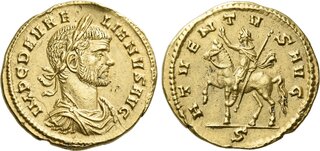Lot description:
Aurelian, 270 – 275.
Aureus, Mediolanum mid 271, AV 20 mm, 4.91 g. IMP C D AVRE – LIANVS AVG Laureate, draped and cuirassed bust r. Rev. ATVENTV – S AVG Emperor on horseback l., holding sceptre and raising r. hand; in exergue, S. C –. RIC –. Göbl –, cf. 27b. (aureus) and cf. 28A (antoninianus with ATVENTVS). Calicó –.
An apparently unrecorded variety of an exceedingly rare type. Several minor marks
and an edge nick at eleven o'clock on reverse, otherwise about extremely fine
Aurelian, arguably the greatest of Rome's so-called military emperors of the third century, hailed from Sirmium in Pannonia Inferior, and was either of very humble origins or possibly of equestrian stock. He joined the legions when he was around twenty years of age, ca. A.D. 235, rising rapidly through the ranks to become, first, a cavalry commander during Gallienus' reign, and subsequently to the position of Magister equitum – cavalry commander and, effectively, the overall commander of the Roman army after the emperor – under Claudius II as well as a member of that emperor's inner circle of advisors. While still a cavalry commander under Gallienus, Aurelian led a contingent in the Battle of Naissus (A.D. 268), which saw the Goths defeated, and participated in the siege of Mediolanum against the usurper Aureolus, during which Gallienus was assassinated and Claudius II was proclaimed the new emperor. Under Claudius II, Aurelian successfully led the cavalry in many engagements against various invading tribes along Rome's borders in Rhaetia and in the Balkans – principle among them the Alemanni and, again, the Goths – and when Claudius succumbed to the plaque in A.D. 270 while himself campaigning against these Germanic tribes the soldiers elevated Aurelian to the purple. Aurelian's first task as emperor was to secure his power by defeating Quintillus, the brother of Claudius II who had been elevated to the throne by the Roman Senate. He made short shrift of the Senate's choice, and the august body had no choice but to immediately confirm his position. With this accomplished, Aurelian set about the task of restoring the res publica, as the previous two decades had seen Rome suffer greatly from incursions of barbarian tribes, widespread instability, devastating plaques, a number of usurpers, and ultimate financial collapse, all of which eventually led to the splintering of the Empire itself. In the west the general Postumus and his successors had created a breakaway Gallic Empire consisting of the Roman provinces of Britannia, Gaul and Spain, while in the east the city of Palmyra under Queen Zenobia and her son took control of much of Asia Minor, Syria and Egypt. By the time Aurelian had secured his position as emperor, the Gallic Empire was on its last legs, and Aurelian decided to wait to deal with it. Thus, in A.D. 272 he focused his attention on the Palmyrene Empire, which had recently cut off shipments of Egyptian grain to Rome, the Eternal City's principal source of food.Marching through Asia Minor, all but two cities – Byzantium and Tyana – opened their gates to Aurelian's troops. At Tyana, the city authorities had refused to submit, but after capturing the city the emperor magnanimously spared its inhabitants. When other cities in the east heard of the emperor's benevolence towards Tyana, they readily opened their gates to the emperor. Thus within six months Aurelian was before the gates of Palmyra itself, which quickly surrendered after its queen fled the city. Aurelian's conquest over the Palmyrene Empire permitted the reinstitution of the Egyptian grain supply to the Empire's capital, thus freeing the city of Rome from imminent starvation. The emperor was hailed as Parthicus Maximus and Restitutor Orientis ("restorer of the East").
Estimate: 10000 CHF |  |